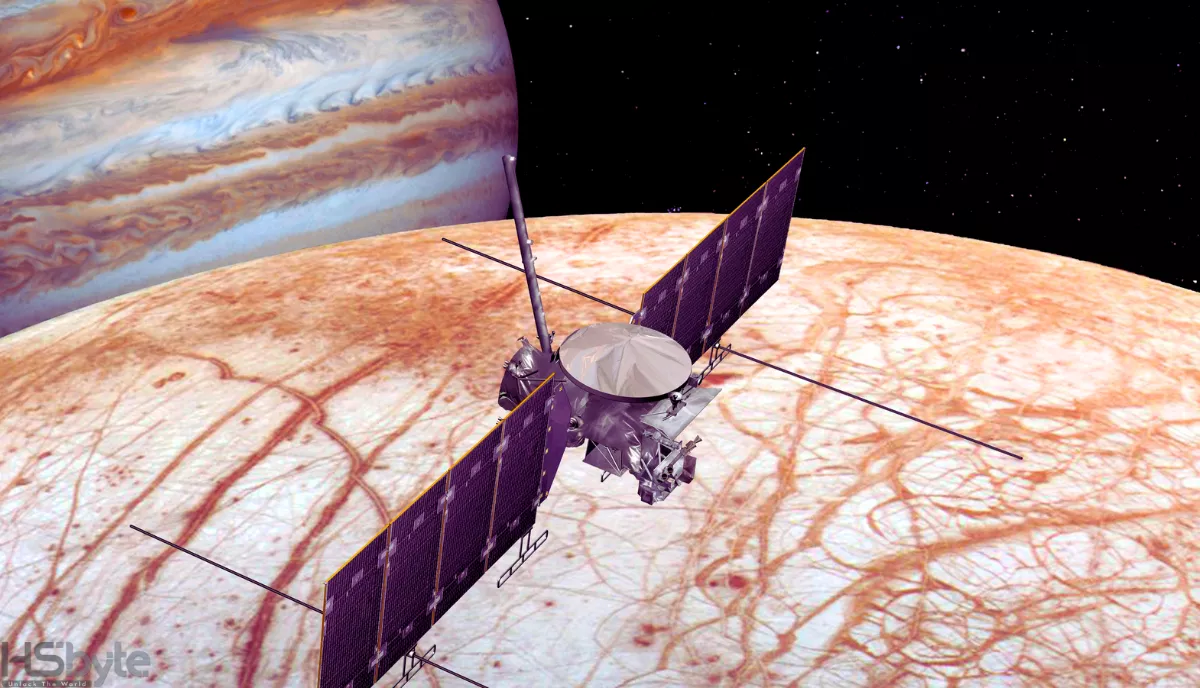
- Category: Innovation

- Share
Europa Clipper Mission Launch: NASA’s Bold Hunt for Alien Life
A NASA spacecraft is about to embark on a groundbreaking journey, launching from Florida to explore Jupiter’s moon Europa. This mission, known as the Europa Clipper, aims to search for signs of alien life hidden beneath Europa’s icy surface.
Exploring Europa’s Icy Depths
Europa, a moon orbiting Jupiter, is believed to harbor a massive ocean beneath its thick ice crust—an ocean that may contain more water than Earth. Scientists speculate that if liquid water, heat, and organic material exist together for long enough, life might emerge. The potential discovery of even microbial life would revolutionize our understanding of life in the universe.
Europa shines five times brighter than Earth’s moon due to its reflective icy surface. Beneath the ice, some areas may resemble Earth’s subduction zones and tectonic activity, offering further clues about habitability. Instruments onboard the Clipper will aim to explore these hidden regions and map the moon’s complex “plumbing.”
NASA’s Clipper vs. Europe’s JUICE Mission
Although the European Space Agency’s JUICE mission launched last year, NASA’s Clipper spacecraft will overtake it using the slingshot effect—a gravity-assisted maneuver around Earth and Mars. The spacecraft is expected to arrive at Europa in 2030, well ahead of JUICE, despite the shared target.
Once in orbit, the Clipper will perform about 50 flybys of Europa, collecting data on water plumes and dust particles. Scientists hope these flybys will reveal the moon’s chemical composition and provide insight into potential landing sites for future missions.
Challenges of Radiation and Technology
Radiation exposure remains one of the mission’s toughest challenges. Each flyby will expose the spacecraft to levels of radiation equivalent to one million X-rays. To safeguard its systems, the Clipper’s core electronics are housed in a heavily shielded vault designed to withstand these intense conditions.
The onboard instruments include advanced sensors and a laser system called Reason, developed to penetrate Europa’s ice and identify hidden water pockets. Tested in Antarctica, these instruments will offer unprecedented insights into the moon’s internal structure.
Originally scheduled for launch earlier this month, the mission was delayed after Hurricane Milton struck Florida, forcing engineers to move the spacecraft indoors. After confirming that the launchpad at Cape Canaveral was undamaged, the team rescheduled the launch for October 14, 2024.
The Europa Clipper represents a mission driven purely by curiosity and exploration, marking a rare departure from the commercial focus dominating space exploration today. As Mark Fox-Powell, a planetary microbiologist, says, “If we discover life on Europa, it implies a separate origin of life—and that could mean life is far more common than we ever imagined.”
A New Era of Space Exploration
The Europa Clipper mission involves collaboration between NASA, the Jet Propulsion Laboratory, Johns Hopkins Applied Physics Lab, and other international partners. Scientists emphasize that this mission isn’t about finding complex organisms but understanding the conditions that might allow life to exist.
Michelle Dougherty, professor of space physics, explains: “We’re not expecting animals or human-like creatures. We are searching for signs of habitability—liquid water, heat, and organic materials. If these ingredients are stable long enough, something extraordinary could happen.”
By pushing the limits of space exploration, the Europa Clipper mission holds the potential to reshape our understanding of life beyond Earth and our place in the cosmos.
You May Also Like


Starship Rocket Test Success: SpaceX’s Historic Feat

Europa Clipper Mission Launch: NASA’s Bold Hunt for Alien Life

Gate Allocation Technology: Quantum Computing Revolution

Telegram User Data Change: What It Means for You

Will the US Presidential Election Shape the Future of Crypto?
Latest Update

Zelensky Biden Meeting Ignites Republican Outrage Amid Aid Talks

Wuthering Heights Film Casting: Controversy Sparks Debate

Will the US Presidential Election Shape the Future of Crypto?

War with Russia: Zelensky Sees Hope for Peace

Unpacking the ‘Dark Arts’ in Manchester City vs Arsenal Showdown

UNIFIL Post Breached: Israeli Tanks Escalate Tensions

Trump Demands Hamas Disarm Amid Brutal Gaza Crackdown

